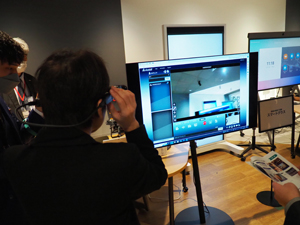Medical/healthcare DX solution experience session NTT Communications

NTT Communications held the “NTT Com Medical/Healthcare DX Solution Experience Session” on Monday the 19th. In light of the arrival of an aging society, the resulting shortage of medical professionals, and the 2024 issue that will restrict overtime work for doctors, the company is promoting DX in the medical and healthcare field and conducting various demonstration experiments. There is.
At the trial session, we will introduce various solutions that support medical settings. In addition to brain health checks using telephones, a hands-free gaze transmission system used by doctors for remote treatment, voice input of electronic medical records using smartphones, and a demonstration of the new service “LocoView” released on the 19th. I did it.
Brain Health Check is a service that allows users to check the state of their brain simply by answering questions from an AI. During the demonstration, brain health was checked through interaction with the company’s digital human ”CONN”.
This service is also available as a toll-free trial service and has been well received. The number of users is increasing not only among the elderly but also among younger people.

ハンズフリー目線伝送システム(Hands-free line of sight transmission system)
The hands-free line-of-sight transmission system makes it possible to streamline and improve medical procedures through remote support. It can be used not only for telemedicine, but also for on-site work such as maintenance and maintenance work.
Voice input of electronic medical records using smartphones dramatically reduces nurses’ work. Entering electronic medical records is a time-consuming job for busy nurses who are always on the go, but when they are not working in the field, they can input a patient’s condition into their smartphone by voice, which is converted into text and reflected in the electronic medical record. Entering electronic medical records, which previously took about five minutes at a time, will now take about 20 seconds. For the nurses working as a whole, this will result in considerable efficiency improvements, making it easier for them to concentrate on their core duties.
When taking photos of a patient’s situation, the photos taken with a smartphone can be transferred to the electronic medical record. Previously, people had to bring a digital camera from a nursing room or other place to take pictures, which meant going back and forth, but this time and effort will be reduced.
LocoView obtains location information of medical workers and patients through communication between beacons installed in hospitals and smartphone apps. Medical workers will be able to grasp the location information of each patient, reducing the time it takes to search for a specific patient and making it possible to flexibly change the order of consultation instructions.
Since medical workers can check each other’s location information, they can take each other’s work situations into consideration. For example, if a doctor is in the exam room, the system can determine that the doctor is attending to an outpatient and select the appropriate communication method, such as sending a chat rather than a phone call.
